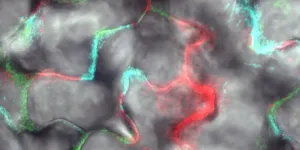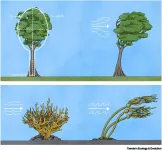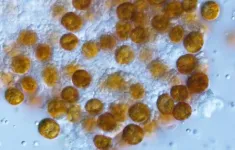Astonishing altitude changes in marathon flights of migratory birds
2021-07-01
(Press-News.org) Extreme differences in flight altitude between day and night may have been an undetected pattern amongst migratory birds - until now. The observation was made by researchers at Lund University in Sweden in a study of great snipes, where they also measured a new altitude record for migratory birds, irrespective of the species, reaching 8 700 metres.
Great snipes are shorebirds that breed in Sweden, among other places, and spend the winter in areas near the equator in Africa. Previous studies have shown that great snipes make long marathon flights of up to 6 000 kilometres lasting 60-90 hours when they migrate between breeding sites in Sweden and wintering sites close to the equator.
In a new study published in Current Biology, the international research team describe how the great snipes fly at a higher altitude during the day than at night. The difference can be as much as several thousand metres. The birds regularly flew at an altitude of over 6 000 metres during the day, compared to an average altitude of about 2 000 metres at night. One bird even flew at over 8 000 metres for five hours during the autumn migration to Africa, reaching a maximum altitude of 8 700 metres.
"It is the highest flight altitude that has ever been recorded for a migratory bird", says Åke Lindström at the Department of Biology in Lund who led the study.
Researchers used small data loggers developed at Lund University and attached these to the great snipes in order to follow changes in flight altitude during the long flights. The record height of 8 700 metres is astonishing.
However, the researchers are even more fascinated by the pattern among migratory birds that they may have detected. A recently published study on great reed warblers, which was also led by researchers in Lund, found that on the few occasions during the migration when the small passerines prolonged their otherwise nocturnal flights into the day, they flew at much higher flight altitudes during the day than at night. This occurred when great reed warblers crossed inhospitable terrain such as the Sahara Desert and the Mediterranean Sea.
The considerably larger great snipes do the same. However, not only when they fly over so-called ecological barriers such as deserts and seas, but also when they fly over the tropics and over Europe.
"Other species that that make long migratory flights are also likely to use this day-and-night rhythm. We may well be tracking a general pattern, it will be up to future studies to show this", says Åke Lindström.
If it transpires to be a pattern amongst many migratory birds, it would enhance our understanding of which environmental factors are important for migratory birds. This knowledge may in turn bring us closer to explaining the great variation in the behaviour of these birds. Why do some species migrate at night and others during the day? Why do some birds only fly short distances at a time while others, such as great snipes fly for several days in a row?
As yet, no one knows for certain why great snipes and great reed warblers fly at a higher altitude in the day than at night during migration. The research team mention three explanations as the most probable: birds can navigate more easily via landmarks, they avoid birds of prey, the cold temperature at high altitudes helps prevent overheating during strenuous exercise under the blazing sun.
"Our main line of inquiry is that they fly at a high altitude to cool down, but we must be humble and acknowledge that there may be other or additional explanations", concludes Åke Lindström.
INFORMATION:
ELSE PRESS RELEASES FROM THIS DATE:
2021-07-01
Chatbots have already become a part of our everyday lives with their quick and intuitive way to complete tasks like scheduling and finding information using natural language conversations. Researchers at Aalto University have now harnessed the power of chatbots to help designers and developers develop new apps and allow end users to find information on the apps on their devices.
The chatbot -- 'Hey GUI' (pronounced goo-ee), short for Graphical User Interface, which will be presented at ACM Designing Interactive Systems 2021 on 1 July -- can answer questions by showing images and screenshots of apps, or through simple text phrases.
"Hey GUI eliminates the need for coding skills or technical ...
2021-07-01
Hundreds of different bacterial species live in and on leaves and roots of plants. A research team led by Julia Vorholt from the Institute of Microbiology at ETH Zurich, together with colleagues in Germany, first inventoried and categorised these bacteria six years ago. Back then, they isolated 224 strains from the various bacterial groups that live on the leaves of thale cress (Arabidopsis thaliana). These can be assembled into simplified, or "synthetic" plant microbiomes. The researchers thus laid the foundations for their two new studies, which were just published in the journals Nature Plants and Nature Microbiology.
Volume control of the plant response
In the first study, the researchers investigated ...
2021-07-01
A team of scientists has devised a more accurate way to predict the effects of climate change on plants and animals -- and whether some will survive at all.
Frequently, ecologists assess an organism's fitness relative to the climate by quantifying its functional traits.
"These are physical properties you can measure -- height, diameter, the thickness of a tree," said UC Riverside biologist Tim Higham. "We believe more information is needed to understand how living things will respond to a changing world."
The team, led by Higham, outlines an alternative model for researchers in an article ...
2021-07-01
NEW YORK, NY (July 1, 2021)--Lowering levels of a hormone called PTHrP can prevent metastases and improve survival in mice with pancreatic cancer and could lead to a new way to treat patients, according to a study from cancer researchers at Columbia University Vagelos College of Physicians and Surgeons and Herbert Irving Comprehensive Cancer Center and with collaborators at the University of Pennsylvania.
When patients are first diagnosed with pancreatic cancer, the cancer usually has spread to other organs. Because of these metastases, nearly all patients will succumb to their cancer within one year of diagnosis, but no drugs exist to prevent metastasis.
In an effort to find treatments, cancer researchers at Columbia--led by ...
2021-07-01
What if a microscope allowed us to explore the 3D microcosm of blood vessels, nerves, and cancer cells instantaneously in virtual reality? What if it could provide views from multiple directions in real time without physically moving the specimen and worked up to 100 times faster than current technology?
UT Southwestern scientists collaborated with colleagues in England and Australia to build and test a novel optical device that converts commonly used microscopes into multiangle projection imaging systems. The invention, described in an article in today's Nature Methods, could open new avenues ...
2021-07-01
SAN FRANCISCO, CA--June 28, 2021--While vaccines are doing a remarkable job of slowing the COVID-19 pandemic, infected people can still die from severe illness and new medications to treat them have been slow to arise. What kills these patients in the end doesn't seem to be the virus itself, but an over-reaction of their immune system that leads to massive inflammation and tissue damage.
By studying a type of immune cells called T cells, a team of Gladstone scientists has uncovered fundamental differences between patients who overcome severe COVID-19 and those who succumb to it. The team, working together with researchers from UC San Francisco and Emory University, also found that dying patients harbor relatively large numbers of T cells able to infiltrate the lung, which may contribute ...
2021-07-01
BUFFALO, N.Y. -- Patients with Type 2 diabetes who were prescribed SGLT2 inhibitors lost more weight than patients who received GLP-1 receptor agonists, according to a University at Buffalo-led study.
The research, which sought to evaluate the difference in weight loss caused by the antidiabetic medications -- both of which work to control blood sugar levels -- found that among 72 patients, people using SGLT2 inhibitors experienced a median weight loss of more than 6 pounds, while those on GLP-1 receptor agonists lost a median of 2.5 pounds.
The findings, published last month ...
2021-07-01
The adult brain is more malleable than previously thought, according to researchers from the Interdisciplinary Center Herzliya. They trained a 50-year-old man, blind from birth, to "see" by ear, and found that neural circuits in his brain formed so-called topographic maps - a type of brain organization previously thought to emerge only in infancy. This finding reported recently in END ...
2021-07-01
Rochester, Minn. -- Mayo Clinic researchers have discovered that genetic variants in a neuro-associated gene called SPTBN1 are responsible for causing a neurodevelopmental disorder. The study, published in Nature Genetics, is a first step in finding a potential therapeutic strategy for this disorder, and it increases the number of genes known to be associated with conditions that affect how the brain functions.
"The gene can now be included in genetic testing for people suspected of having a neurodevelopmental disorder, which may end the diagnostic odyssey these people and their families have endured," says Margot Cousin, Ph.D., a translational ...
2021-07-01
UNIVERSITY PARK, Pa. -- In the late 1800s, scientists were stumped by the "yellow cells" they were observing within the tissues of certain temperate marine animals, including sea anemones, corals and jellyfish. Were these cells part of the animal or separate organisms? If separate, were they parasites or did they confer a benefit to the host?
In a paper published in the journal Nature in 1882, biologist Sir Patrick Geddes of Edinburgh University proffered that not only were these cells distinct entities, but they were also beneficial to the animals in which they lived. He assigned them to a new genus, Philozoon -- from the Greek phileo, meaning 'to love ...
LAST 30 PRESS RELEASES:
[Press-News.org] Astonishing altitude changes in marathon flights of migratory birds






